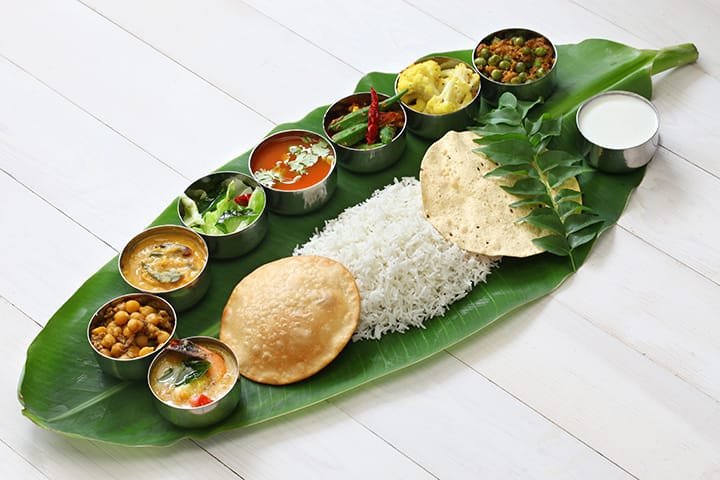
It’s a dynamic culinary tapestry woven from ancient Dravidian roots, temple traditions, spice trade routes, colonial exchanges, and modern innovations, reflecting the diversity of Tamil Nadu, Kerala, Karnataka, Andhra, Telangana, and Puducherry. Let’s explore how this cuisine evolved into a global comfort and festival favorite.
Ancient Roots: Rice, Rituals, and Simplicity
Over 4,000 years ago, South Indian cuisine was born in the agrarian Dravidian heartlands, where rice and millets formed the daily diet, paired with seasonal vegetables and pickles served on banana leaves.

Fermentation: The Game-Changer
Between 800–1200 CE, the magic of fermentation transformed South Indian kitchens:
✅ Idli (steamed rice-lentil cakes) is believed to have Southeast Asian influences, first appearing in Kannada and Sanskrit texts around 920 CE.
✅ Dosa (fermented rice-lentil crepe) emerged on the streets around Karnataka temples by the 5th century, with Tamil records dating back to 1054 CE.
Regional Diversity: A Culinary Mosaic
Tamil Nadu & Karnataka:
Temple cuisine emphasizing rice with sambar, rasam, vathals, poriyal, and pachadi.
Kerala:
Coastal and coconut-heavy dishes like meen pollichathu (fish in banana leaf), prawn curry, avial, and olan, paired with red rice and appam.
Andhra & Telangana:
Fiery dishes using red chilies, gongura (sorrel leaves), and tamarind in Andhra pepper chicken, gongura mutton, and spicy pickles.
🇫🇷 Puducherry:
French influences blending with Tamil cuisine, producing unique dishes like prawn vindaloo and baguettes with chutney.
Influences of Trade, Empires, and Colonization
The Mughal and Persian eras introduced biryani and kebabs, influencing Hyderabadi cuisine.

Modern Innovation & Global Expansion
In the 20th century, Udupi restaurants popularized masala dosa and sambar nationwide, making them staples in Indian cities and abroad.
Everyday South Indian Home Dishes
Contrary to popular belief, South Indians don’t eat dosa and idli daily. Here’s what’s commonly cooked in homes:
Staple Meals:
- Steamed rice with sambar, rasam, or dal.
- Curd rice with cucumber and tempering for cooling effect.
Breakfast:
- Idli with coconut chutney and sambar.
- Dosa variants: masala dosa, neer dosa, ghee roast.
- Uttapam topped with onions and tomatoes.
- Rava idli for quick mornings.
- Medu vada with sambar.
Veggies & Sides:
- Poriyal: Stir-fried veggies with coconut.
- Kootu/Molagootal: Mild coconut-lentil stews.
- Kosambari: Fresh salads with coconut and lemon.
Rice Variants:
- Lemon rice, coconut rice, tomato rice, mango rice.
- Puliyogare (tamarind rice) for travel and festivals.
Snacks & Sweets:
- Paniyaram (savory dumplings).
- Vada varieties for evening tiffin.
Festival Padayal:
- Rice, sambar, rasam, poriyal, kootu, vada, papad, pickle, payasam—all served on banana leaves.
South Indian Cuisine’s Global Recognition
Over 2 million Tamil, Telugu, Kannada, and Malayali migrants have taken their culinary traditions abroad, setting up dosa stalls in Malaysia, Singapore, the UK, the US, and the Middle East.
The term “curry” may trace its origins to the Tamil word “kari,” showing the deep linguistic and culinary impact of South India on global food culture.
A 4,000-year evolution from millet-based agrarian diets to globally loved comfort food.
A reflection of temple rituals, trade routes, and family traditions.
A testament to culinary creativity using fermentation, tempering, and spice layering.
A diverse ecosystem covering fiery Andhra gravies, coconut-laced Kerala seafood, Tamil rice dishes, and Karnataka’s Udupi traditions.
A Short Travel Guide for Foodies Exploring South Indian Cuisine
Must-Visit Regions:
✅ Chennai & Madurai (Tamil Nadu) – Sappadu meals, temple feasts.
✅ Bangalore & Udupi (Karnataka) – Udupi vegetarian thalis, filter coffee.
✅ Kochi & Alleppey (Kerala) – Seafood curries, toddy shop experiences.
✅ Hyderabad (Telangana) – Hyderabadi biryani, Andhra meals.
Must-Try Dishes:
- Masala dosa with chutney and sambar.
- Kerala meen curry with appam.
- Andhra gongura mutton.
- Chettinad pepper chicken.
- Payasam or Mysore pak for dessert.
Travel Tips:
- Explore local messes and tiffin centers for authentic experiences.
- Learn about spice plantations in Kerala.
Frequently Asked Questions
Is South Indian food always spicy?
No, it ranges from mild coconut stews to fiery Andhra curries, with spice levels adaptable.
Can vegetarians enjoy South Indian cuisine?
Absolutely! It is one of the most vegetarian-friendly regional cuisines in India.
Final Thoughts: South Indian Cuisine, A Culinary Symphony
South Indian cuisine is a living, evolving culinary art—rooted in tradition yet embracing innovation. From temple kitchens to modern cafes, it carries a rich heritage of flavor, balance, and nourishment that extends far beyond dosas and idlis.
Additional Resources:
FOR MORE BLOGS – beyondthepunchlines.com

 Add to favorites
Add to favorites







